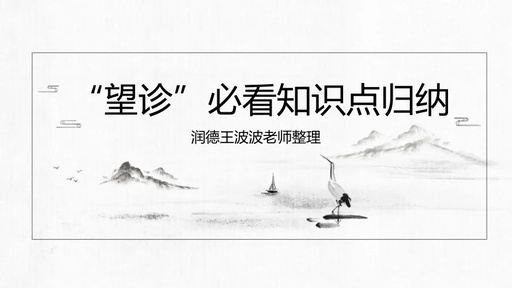
Teacher Wang Bobo provides practical exam preparation tips for 2018 licensed pharmacist candidates
Hello everyone, I am Teacher Wang Bobo.
Chapter Two of Comprehensive Chinese Medicine is the foundation of TCM diagnosis, which is a key focus of the exam every year. However, to score well on this section, one must memorize a large amount of content, which is not an easy task for most candidates. Therefore, today, Teacher Wang Bobo will summarize the key points of “Wang” (Observation) for everyone, and in the next issue, I will provide the remaining content.
Wang Zhen, as the name suggests, is a method of understanding disease conditions through observing the patient’s spirit, color, form, state, tongue appearance, as well as changes in secretions and excretions.
★Wang Shen (Observation of Spirit)★
Shen refers to the spirit and mental state. It is often said that “the eyes are the windows to the soul”; changes in the eyes can reflect a person’s current state and are an important basis for quickly determining whether someone is ill.
|
Classification |
Clinical Manifestations |
Etiology and Pathogenesis |
|
|
With Shen (De Shen) |
Bright eyes, responsive, clear speech |
Upright Qi is intact, organ functions are not weakened |
|
|
Loss of Shen (Wu Shen) |
Dull gaze, lethargic spirit, slow response |
Upright Qi is damaged |
|
|
False Shen |
Initially unwilling to speak, voice weak, suddenly becomes talkative; Initially dull complexion, suddenly flushed cheeks |
Chronic illness, severe illness, extreme weakness of Qi, also known as “return of light” |
|
|
Disordered Shen |
Epilepsy |
Talks little, then becomes dazed, laughing and crying uncontrollably |
Phlegm and Qi stagnation |
|
Mania |
Restless and agitated, shouting and cursing |
Heart disturbed by fire |
|
|
Seizures |
Foaming at the mouth, sudden collapse |
Phlegm obstructing the heart, internal wind |
★Wang Se (Observation of Color)★
Se refers to the color and luster of the face; a rosy complexion indicates good health. A dull complexion suggests a serious condition that has harmed the Qi.
As mentioned in the discussion of the Five Elements theory, the colors correspond to different organs: green, red, yellow, white, and black correspond to the liver, heart, spleen, lungs, and kidneys, respectively. For example, a black face corresponds to kidney deficiency; a pale yellow face corresponds to spleen and stomach Qi deficiency.
|
Item |
Content |
|
|
White |
Mainly indicates deficiency-cold syndrome, followed by blood loss syndrome |
㿠白而虚浮: Yang Qi is insufficient; Pale and thin:Ying blood deficiency |
|
Yellow |
Mainly indicates deficiency syndrome, damp syndrome |
Pale yellow complexion, known as “withered yellow,”spleen and stomach Qi deficiency, Ying blood cannot nourish Yellow complexion, eyes, and body, known as jaundice, often due to damp-heat |
|
Red |
Mainly indicates heat syndrome |
Bright red face, indicates excess heat in the organs Only facial redness:Yang excess and deficiency heatsyndrome |
|
Green |
Mainly indicates cold syndrome, pain syndrome, blood stasis syndrome, wind syndrome |
Pale with a greenish hue: internal excess of Yin-cold Face appears bluish-gray, lips are cyanotic, Qi deficiency and blood stasis High fever in children, face turns bluish, a sign of impending wind syndrome |
|
Black |
Mainly indicates kidney deficiency syndrome, water retention syndrome, blood stasis syndrome |
Dry and black face: prolonged depletion of kidney essence Black around the eyes: water retention disease, cold dampness leading to discharge syndrome |
★Wang Tou Mian (Observation of Head and Face)★
Next, let’s look at the shape of the head; the fontanelle is the top of our head, divided into the anterior and posterior fontanelles. By observing the fontanelle, we can determine whether the patient has a deficiency or excess syndrome.
Sunken fontanelle: deficiency syndrome
Prominent fontanelle: excess syndrome
Delayed closure of the fontanelle: weak head and neck unable to stand, insufficient kidney Qi, developmental issues.
In addition to the shape of the fontanelle, let’s see what information the hair can provide us.
Patchy hair loss: blood deficiency with wind invasion
Hair loss at a young age: kidney deficiency or blood heat
Thin and easily falling hair, or dry and un-nourished, often indicates deficiency of essence and blood.
★Wang Er Bi (Observation of Ears and Nose)★
Dry and black ear rims: kidney essence depletion, lack of nourishment, indicating a critical condition (the term “critical condition” indicates a special case that requires attention)
Pus discharge from the ear: liver and gallbladder damp-heat
The lips belong to the Earth element and are closely related to the spleen. The spleen governs transformation and transportation, while the stomach receives and holds, both belonging to the middle burner, sharing the responsibility of generating Qi and blood.
Saliva flowing from the corners of the mouth: spleen deficiency with excess dampness or stomach heat, damp-heat cannot disperse, flowing out from the corners of the mouth, is a self-regulating mechanism of the body.
Chapped lips: heat in the spleen and stomach rising. Chapped lips are commonly known to indicate excess heat, and the heat cannot escape, reflecting on the lips connected to the spleen.
Everyone knows that lips are thin, and their color actually reflects blood color.
Deep red lips: heat in Ying blood
Pale white lips: deficiency of Qi and blood
Cyanotic lips: cold congealing blood stasis
The above should not be difficult to understand.
★Wang Yan Hou (Observation of Throat)★
Although the throat is not part of the five zang-fu organs, it is an important “passage” for ensuring the normal functioning of the body. The throat is related to Qi and connects to the lungs; the pharynx is the esophagus, connecting to the stomach, and the two are closely related.
Red and swollen throat: heat accumulation in the lungs and stomach. Redness and swelling are often related to heat; the appearance of redness and swelling in the throat indicates that the lungs and stomach, which are closely related, have issues.
A bright red and tender throat, with severe pain, contrasts sharply with the above. Bright red indicates excessive fire, accompanied by severe pain, which is a more extreme condition, suggesting Yin deficiency with excessive fire.
A grayish-white false membrane in the throat is a manifestation of diphtheria, which everyone needs to remember.
★Wang She (Observation of Tongue)★
Compared to the above methods, observation of the tongue provides even more information. In the Five Elements classification, the tongue corresponds to the heart, which is the master of the five zang organs and governs blood vessels. Through the tongue, we can observe the circulation of Qi and blood within the body and identify where pathological changes have occurred.
|
Color |
Significance |
|
Pale white tongue |
Mainly indicates deficiency-cold syndrome, insufficient Qi and blood |
|
Red tongue |
Mainly indicates heat syndrome |
|
Crimson tongue |
Mainly indicates severe internal heat, external heat disease (evil heat entering Ying blood), internal injuries and miscellaneous diseases often belong to Yin deficiency with excessive fire |
|
Purple tongue |
Mainly indicates cold, heat, internal excess of Yin-cold, and excessive evil heat |
Not only the color of the tongue but also its shape can provide us with a lot of information.
Thin and slender tongue: generally, when we see a very thin person, it gives a sense of weakness; the same applies to the tongue, which appears thinner when Qi and blood are weak.
Thin and slender tongue: indicates deficiency of Yin and blood, tongue body is not full.
Thin and pale tongue: indicates deficiency of Qi and blood
Thin and red tongue, dry: indicates Yin deficiency with excessive fire, and fluid depletion.
Cracked tongue: mainly caused by excessive heart fire, leading to the tongue resembling cracked land. Therefore, a cracked tongue corresponds mainly to Yin fluid deficiency.
Red and cracked tongue:excessive heat injuring fluids, deficiency of Yin essence
White tongue with cracks: indicates blood deficiency and lack of moisture
Indented tongue is similar to a swollen tongue, both caused by spleen deficiency. The spleen is responsible for transporting and transforming the essence of food and water; when its function is affected, moisture cannot be properly processed, accumulating on the tongue, causing swelling, which presses against the teeth, resulting in an indented tongue.
Indented tongue: indicates spleen deficiency.
Pale and moist tongue:indicates spleen deficiency with excess cold and dampness.
Thorny tongue: indicates excessive heat evil.
★Wang Pai Chu Wu (Observation of Excretions)★
Excretions include phlegm, vomit, stool, and urine; here we focus on stool.
(1) Watery stool indicates cold dampness.
(2) Loose stool like paste, yellow and sticky, indicates damp-heat in the intestines.
(3) Stool like sticky rice, mixed with pus and blood, indicates dysentery.
(4) Blood before stool, dark brown. Dark brown blood indicates a long time has passed, being far from the anus, with a longer retention time.
(5) Blood after stool, bright red. Bright red blood indicates a shorter retention time, being closer to the anus.
Summarizing too much content at once can be overwhelming for many students, so today we will summarize the knowledge points of Wang Zhen. Please remember to pay attention to Teacher Wang Bobo’s latest updates, as there will be pre-exam activities coming soon!

